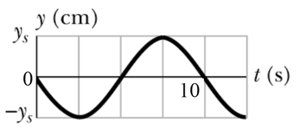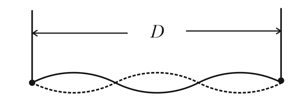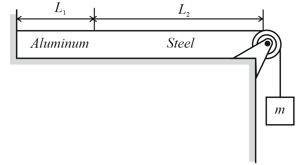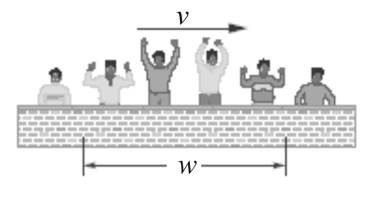A sinusoidal transverse wave of wavelength travels along a string in the positive direction of an -axis. The displacement of the string particle at is given in the figure shown below as a function of time The scale of the vertical axis is set by . The wave equation is to be in the form .
(a) At , is a plot of versus in the shape of a positive sine function or a negative sine function?
What are (b) , (c) , (d) , (e) , (f) the sign in front of and (g) the speed of the wave?
(h) What is the transverse velocity of the particle at when ?

(h) What is the transverse velocity of the particle at when ?


Important Questions on Waves-I
Two sinusoidal waves of the same frequency are to be sent in the same direction along a taut string. One wave has an amplitude of , the other .
(a) What phase difference between the two waves results in the smallest amplitude of the resultant wave?
(b) What is that smallest amplitude?
(c) What phase difference results in the largest amplitude of the resultant wave?
(d) What is that largest amplitude?
(e) What is the resultant amplitude if the phase angle is
A nylon guitar string has a linear density of and is under a tension of . The fixed supports are distance apart. The string is oscillating in the standing wave pattern shown in the figure shown below. Calculate the (a) speed, (b) wavelength, and (c) frequency of the traveling waves whose superposition gives this standing wave.

A sinusoidal wave of angular frequency and amplitude is sent along a cord with linear density and tension . (a) What is the average rate at which the energy is transported by the wave to the opposite end of the cord?
(b) If simultaneously, an identical wave travels along an adjacent, identical cord. what is the total average rate at which energy is transported to the opposite ends of the two cords by the waves? If, instead those two waves are sent along the same cord simultaneously. What is the total average rate at which they transport energy, when their phase difference is (c), (d), and (e) ?
A generator at one end of a very long string creates a wave given by
and a generator at the other end creates the wave
Calculate the (a) frequency, (b) wavelength, and (c) speed of each wave. For , what is the location of the node having the (d) smallest, (e) second smallest, and (f) third smallest value of ? For what is the location of the antinode having the (g) smallest.
(h) second smallest, and (i) third smallest value of ?
In figure shown below, an aluminum wire, of length cross-sectional area and density is joined to a
steel wire, of density and the same cross-sectional area. The compound wire, loaded with a block of mass is arranged so that the distance from the joint to the supporting pulley is . Transverse waves are set up on the wire by an external source of variable frequency; a node is located at the pulley. (a) Find the lowest frequency that generates a standing wave having the joint as one of the nodes. (b) How many nodes are observed at this frequency?

A human wave. During sporting events within large, densely packed stadiums, spectators will send a wave (or pulse) around the stadium (in the figure shown below). As the wave reaches a group of spectators, they stand with a cheer and then sit. At any instant, the width of the wave is the distance from the leading edge (people are just about to stand) to the trailing edge (people have just sat down). Suppose a human wave travels a distance of 853 seats around a stadium in , with spectators requiring about to respond to the wave's passage by standing and then sitting. What are (a) the wave speed (in seats per second) and (b) width w (in number of seats)?

What are (a) the wave speed and (b) the tension in the string?
